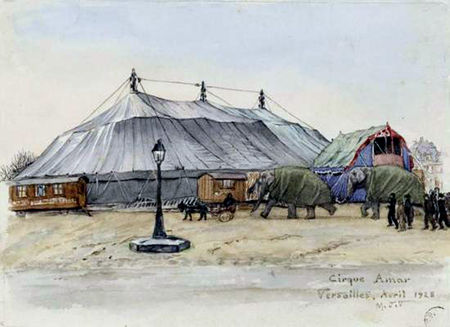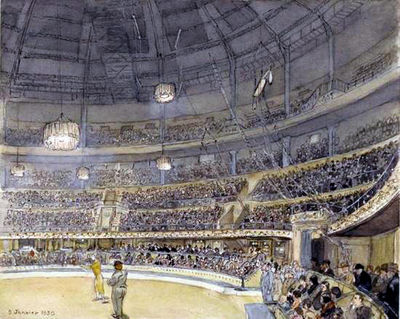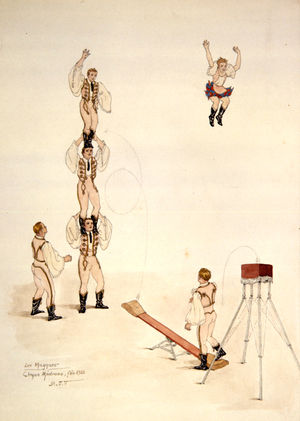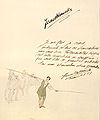Marthe and Juliette Vesque
From Circopedia
Contents
Circus Memorialists
By Dominique Jando
For a half-century (roughly from 1900 to 1950), Marthe (1879-1949) and Juliette (1881-1962) Vesque have documented the Parisian circus scene in meticulously precise paintings of circus artists in performance—about whom they often added fascinating information in their journal, which they wrote from 1904 to 1947. They sketched their subjects live, at the circus or in variety theaters, which they frequented assiduously every week. Their unique art production constitutes perhaps the most remarkable visual documentation existing on the European circus of the first half of the twentieth century.
Les Demoiselles Vesque
Known in the French circus milieu as "les demoiselles Vesque," or—somewhat more fittingly because it rings like the name of a circus act—"les sœurs Vesque" (the Vesque sisters), Marthe and Juliette Vesque spent their lives together, never married, and shared not only the same occupation, but also the same passions. Marthe was born in 1879 in Joinville-le-Pont, a suburb of Paris, and Juliette, who was born in Paris, followed her in 1881.
Their father, Julien Vesque (1848-1895), was a respected botanist; he was Maître de Conférences (Professor) at the Institut Agronomique in Paris and had published an important Traité de Botanique agricole et industrielle in 1885. Like most botanists of his era, Julien Vesque used to make meticulous drawings of his observations. He passed his artistic talents on to his daughters, and was not only their first art teacher, but he also taught them how to do precise and accurate renderings through careful observation.Marthe and Juliette developed a passion for the circus at an early age. In the first half of the twentieth century, Paris was Europe’s circus capital. During their lifetime, they were able to visit regularly not only the Cirque d’Hiver and Cirque Medrano, which preceded and survived them, but also other Parisian circuses: The Nouveau Cirque, until 1926; the Cirque Métropole (later Cirque de Paris) from 1906 to 1930; the Hippodrome de la Place Clichy from 1900 to 1907; and the Empire Music-Hall Cirque from 1924 to 1937.
They may also have visited, in their childhood and adolescence, the Hippodrome de l’Alma, which gave its last performance in November 1892, and the legendary Cirque des Champs-Elysées, which closed in 1898. To this list, one must add the many traveling circuses that visited Paris and its suburbs and the few they saw in their travels, and an equally important number of Parisian revue and variety theaters, such as the Folies Bergère, the Casino de Paris, the Olympia, the ABC, and the Alhambra. All those great theaters presented circus acts regularly.
What brought Marthe and Juliette so close together may have been the untimely death of their father, in 1895, when Marthe was sixteen, and Juliette only fourteen (nothing is known of their mother). The Vesque sisters eventually became professional artists. From 1901 to 1925, they worked for the Manufacture de Sèvres, the leading French porcelain manufacture, where they hand-painted floral decorations on plates, cups, vases, and other objects. They left the Manufacture when its decorative style changed with the Jazz Age (they didn’t like it anymore), and went on to work for the Museum d’histoire naturelle (Natural History Museum), where they painted zoological illustrations, specializing in entomology. They also illustrated specialized books on flora, and did several plates for the Larousse Encyclopedia.
A Jealously Kept Collection
The rest of the time, they were at the circus or at the music-hall (variety theater), sketching the acts they saw, chatting with circus folks, and adding entries to their journal after the show. This was indeed a devouring passion: At that time, Parisian circuses and music-halls renewed their programs every two or three weeks, and the sisters rarely missed one! Although they would have found many buyers, they always refused to sell their paintings, which they kept jealously; they presented a few of them, however, as a gift to selected friends who were, like them, hard-core circus aficionados—mostly journalists and circus chroniclers.Before she passed away on February 4, 1949, Marthe Vesque asked her sister to never sell their collection, and never disperse it. In 1955, Juliette began to donate it, in installments, to the Musée national des Arts et Tradition Populaires, which had been newly created by another circus enthusiast, Georges-Henri Rivière. It was difficult indeed for Juliette to part with these souvenirs—souvenirs of her sister (the paintings were always signed by both sisters: M.J.V. or M.J. Vesque), and specific memories of their common passion.
After her sister’s death, Juliette stopped sketching the circus, but she wrote articles for the French circus magazine, Le Cirque dans l’Univers. After so many years around circus rings, she was indeed very knowledgeable, and her judgment in matter of circus arts was very sure. Juliette Vesque died on December 4, 1962, after a long illness. The remaining of their collection, and their journal, finally reached the Musée des Arts et Traditions Populaires in 1968.
It is indeed a huge collection—hundreds and hundreds of paintings gathered in several large volumes. A very small selection of them have been published in book form: In black and white in Le Cirque en Images (1978), and in color in En Piste! (1992), the latter including excerpts of their journal. The collections of the Musée des Arts et Traditions Populaires are now part of the new MuCEM (Museum of Civilizations from Europe and the Mediterranean), which opened its doors in 2013 in Marseille, France. It certainly seems an odd repository for the amazing circus documentation created by Marthe and Juliette Vesque—and nobody knows yet if or when it will be visible: Over the years, it seems that its official guardians have kept the privacy of their collection even more jealously than the sisters Vesque themselves! Their journal, however, can be consulted on the web.
Suggested Reading
- Edith Mauriange et Paul Bouissac, Le Cirque en Images (Paris, G.-P. Maisonneuve et Larose, 1978)
- Bernadette Boustany, En Piste! — Le cirque en images des sœurs Vesque (Paris, Découvertes Gallimard, 1992) — ISBN 2-07-056659-5











































































